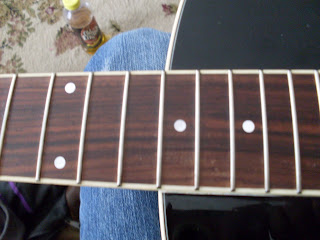









I restrung two of my student's guitars today and thought I'd do a pictorial on how to for anyone interested in saving $30. Most shops charge that much to restring your guitar and it's a simple task anyone can do.
Let's start with the acoustic.
The fretboard was nasty and the strings were black when I started. I took off the strings by using a peghead winder and loosening the tension. I then removed them from the posts and used my left hand inside the cavity to push up on the bridge pins and remove the tails of the strings. This helps to keep the top from being scratched by using other tools to remove the pins. Even the puller on the winder can mar the surface of the guitar so reaching inside is a good thing.
After all the strings were clear of the instrument I proceeded to lightly run quad 0 steel wool over the frets and fingerboard. This polishes the tops of the frets and makes them feel slick when playing. It's important to blow off any debris that is leftover from this step to prevent scratching of the finish when you wipe the instrument down at the end of stringing.
I then proceeded to apply a very light coat of lemon oil on to a cloth baby diaper and then rub it into the fretboard and bridge. This replenishes the moisture in them both and makes the wood appear new. Check out the before and after of the bridge. The wood looks much nicer after the lemon oil.
I then string the guitar up by anchoring each string at the bridge pin and then keeping a light tension on it thread it onto it's peg. I use the winder then to wrap it taut. I should also mention I cut each string at the next peghead up to prevent overwrapping the tuner and to leave a nice tidy wrap.
Check that out in the following sequence for the electric.
When you restring a standard Strat/Tele style guitar you can take off all six strings and do the fretboard cleaning like I mentioned above. I also make sure that as I thread the strings they are fully seated in the bridge cavity and not hung on the lip of the tremolo cover before tightening. This prevents bends in the middle of the string when the string sets into it's slot if you did it incorrectly. The fretboard and strings were pretty raunchy on this axe. When I finished it and had it tuned up you'd of thought it was new. Fresh strings and diligent cleaning after playing will insure your instrument stays in performance shape.
No comments:
Post a Comment